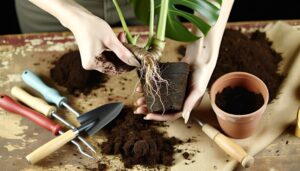Do Monstera Plants Like to Be Root Bound? Surprising Facts!
Monstera plants don’t like being root bound. Their extensive root systems need space to access nutrients and water efficiently.
When root bound, you’ll notice stunted growth, yellowing leaves, and roots circling the pot. Repotting into a larger container with proper drainage and a balanced soil mix, including peat moss, perlite, and pine bark, promotes healthy growth.
Regularly check for these signs and repot when necessary to prevent plant stress and nutrient deficiencies. Proper light, water, and soil conditions are pivotal for their vitality.
Learn how to maintain an ideal environment for your Monstera to flourish.
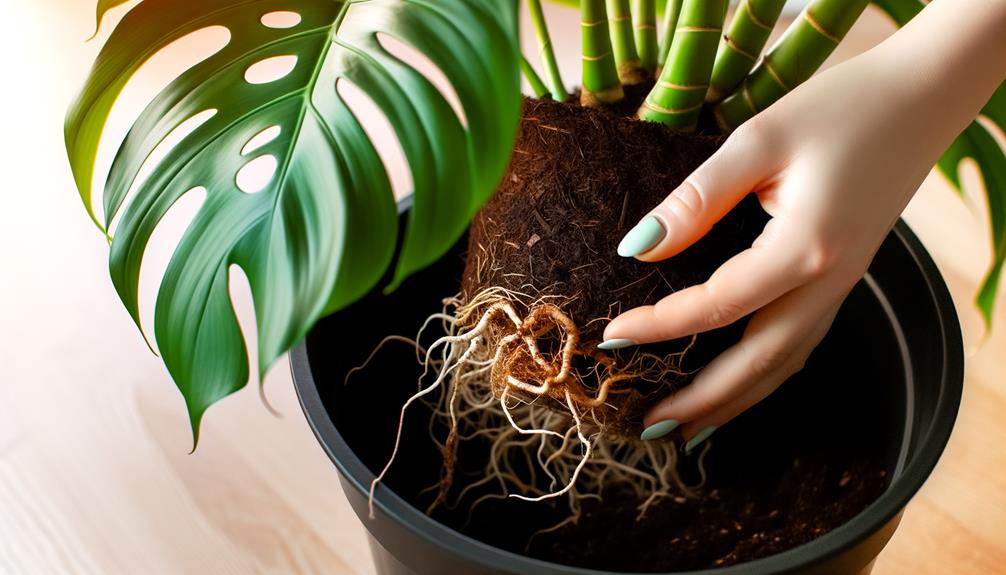
Key Takeaways
- Monstera plants do not thrive when root bound; it hinders growth and nutrient uptake.
- Signs of root binding in Monstera include stunted growth, yellowing leaves, and a dense root mat.
- Root binding in Monstera can cause energy deficits leading to leaf chlorosis and poor overall health.
- Repotting alleviates root congestion, improves nutrient absorption, and promotes healthier growth.
- Choosing a pot with good drainage and ample space prevents root binding and supports Monstera vitality.
Understanding Root Bound

Understanding when a Monstera plant is root bound involves recognizing specific signs such as roots encircling the pot or sticking out from drainage holes.
You’ll notice reduced growth rates or yellowing leaves, which are indicators the plant can’t access sufficient nutrients and water. Root binding can stress your Monstera, leading to stunted development.
Examine the soil surface and the pot’s bottom; if roots form a dense mat, it’s time to repot. Another sign is if water drains too quickly, indicating the soil is crowded with roots.
Ensuring ideal conditions involves regular checks and understanding these signs, allowing you to maintain a healthy Monstera. By recognizing these indicators, you can take timely action to support your plant’s growth and vigor.
Monstera Root Structure
Monstera plants possess a complex root structure, characterized by both fibrous and aerial roots that play distinct roles in nutrient absorption and structural support.
The fibrous roots, located in the soil, maximize water and nutrient uptake, ensuring the plant’s overall health. These roots are highly efficient in drawing essential minerals from the substrate.
Conversely, aerial roots emerge above ground and aid in anchoring the plant to surfaces like trees in their natural habitat. They also absorb moisture and nutrients from the air, contributing to the plant’s robustness.
Understanding this dual root system is essential for best care, as it highlights the need for both soil and air-based resources, enhancing the Monstera’s growth and stability.
Signs of Root Bound Plants
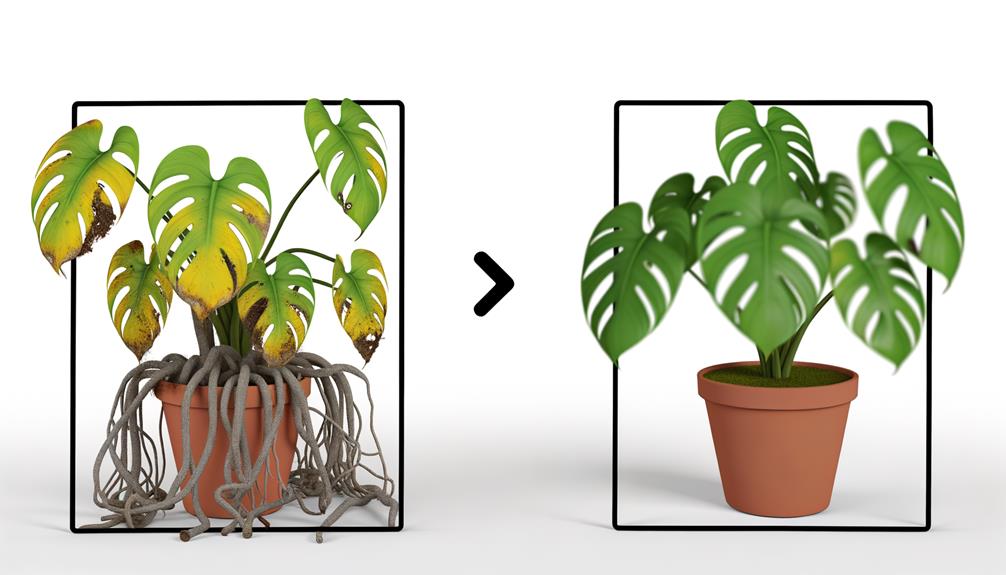
You’ll notice signs of a root-bound Monstera through stunted growth indicators, such as smaller leaves and slowed overall development. Additionally, root circling patterns become evident when roots spiral around the pot’s interior, which restricts nutrient uptake.
Identifying these symptoms early lets you take corrective measures, promoting healthier plant growth.
Stunted Growth Indicators
When you notice your plant’s leaves yellowing and growth rate slowing considerably, these are clear indicators that your Monstera might be root bound. Stunted growth is a common sign; the roots have no space to expand, limiting nutrient uptake.
This restriction leads to smaller, less vibrant leaves and overall poor health. Additionally, wilting despite regular watering suggests the roots can’t effectively absorb moisture.
| Indicator | Explanation |
|---|---|
| Yellowing Leaves | Limited nutrient absorption due to cramped roots |
| Slow Growth Rate | Roots restricted, hindering growth |
| Wilting Despite Watering | Inadequate moisture uptake by congested roots |
Recognizing these symptoms early allows for timely intervention, ensuring your Monstera maintains its vitality. Regular checks on root health are essential to prevent long-term damage.
Root Circling Patterns
Observing root circling patterns is a definitive method to identify if your Monstera is root bound, as these patterns indicate that the roots have run out of space to grow and have started wrapping around the pot’s perimeter.
When you remove the plant from its container, look for roots forming dense, circular patterns. These tangles can impede nutrient and water absorption, stressing the plant. Evidence shows that prolonged root circling can lead to root girdling, where roots strangle themselves, limiting growth.
Additionally, you might notice the roots emerging from drainage holes, another clear sign. Addressing root bound conditions early can prevent further complications, ensuring your Monstera remains healthy and continues to thrive in its environment.
Effects on Growth
When your Monstera becomes root bound, you’ll notice stunted leaf development due to limited space for root expansion.
This restriction also hinders nutrient uptake, directly impacting the plant’s overall health.
Consequently, root health issues such as decay or nutrient deficiencies may arise, further compromising growth.
Stunted Leaf Development
Stunted leaf development in Monstera plants, often caused by root bound conditions, directly impacts overall growth by limiting the plant’s ability to photosynthesize efficiently.
When roots are congested, they can’t expand to absorb sufficient water and nutrients, leading to smaller, underdeveloped leaves. Smaller leaves mean a reduced surface area for photosynthesis, which diminishes the plant’s energy production. This energy deficit stymies growth and can cause leaf chlorosis, where leaves turn yellow due to lacking chlorophyll.
Studies show that inadequate root space restricts physiological processes essential for leaf expansion and health. You’ll notice fewer fenestrations, the characteristic splits in Monstera leaves, which greatly diminishes the plant’s aesthetic appeal and overall robustness.
In short, root bound conditions severely hamper Monstera leaf development.
Limited Nutrient Uptake
A root bound Monstera plant faces significant challenges in nutrient absorption, critically impairing its growth and health. When roots become densely packed, they lack the space to efficiently absorb necessary nutrients from the soil. This leads to deficiencies in crucial elements such as nitrogen, phosphorus, and potassium, all essential for strong growth and foliage development.
Research indicates that restricted root zones limit the plant’s ability to transport water and minerals, resulting in symptoms like chlorosis and stunted growth. Additionally, the competition among roots for limited resources further worsens nutrient scarcity.
Root Health Issues
Root health issues in a Monstera plant can lead to significant disruptions in its growth patterns and overall well-being. When roots become bound, they can’t effectively access the nutrients and oxygen they need.
This restriction can cause stunted growth, yellowing leaves, and even root rot due to poor drainage. Evidence suggests that root-bound conditions can also stress the plant, making it more susceptible to pests and diseases.
You’ll notice that the plant’s foliage appears less vibrant and the overall vigor diminishes. To maintain peak root health, regularly check the root system and repot when necessary. Ensuring proper soil aeration and drainage can prevent these adverse effects, promoting a healthy, thriving Monstera.
Repotting Benefits
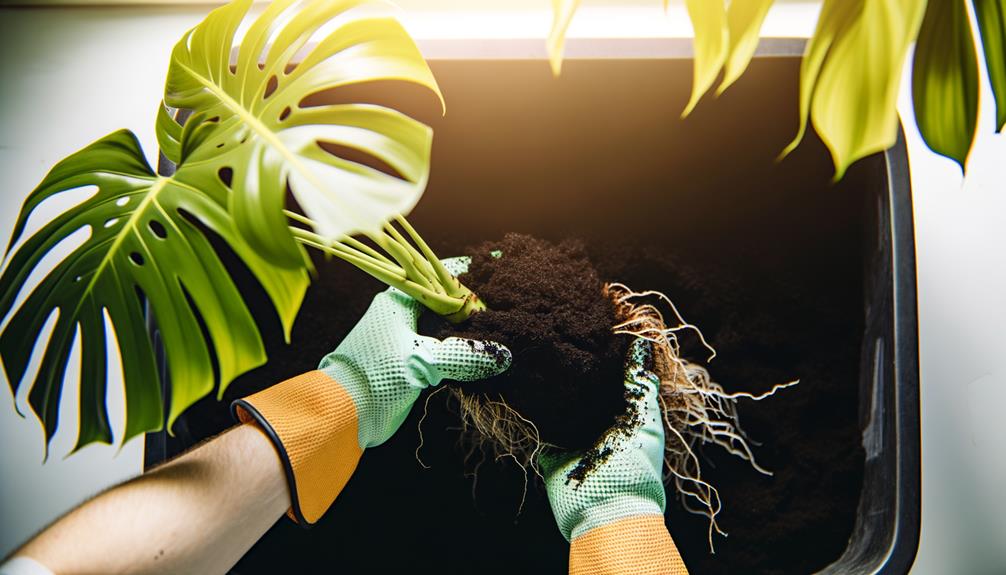
Repotting Monstera plants offers several key benefits, including improved nutrient availability, enhanced root health, and ideal growth conditions.
When you repot, you provide fresh soil rich in essential nutrients, which supports vigorous growth and robust foliage. Additionally, repotting alleviates root congestion, preventing issues like root rot and nutrient deficiencies.
A less crowded root system can better absorb water and nutrients, ensuring the plant thrives. Furthermore, repotting enhances aeration and drainage, essential for preventing waterlogged conditions that can harm Monstera roots.
Regularly repotting also allows you to inspect roots for pests or diseases, addressing problems early. These benefits collectively foster a healthier, more resilient Monstera plant, promoting sustained and optimal development.
Choosing the Right Pot
Selecting the right pot for your Monstera involves considering factors like material, size, and drainage capabilities to maximize growth and health. Opt for terracotta or ceramic pots, as they offer excellent aeration and stability.
Size matters; choose a pot 2-4 inches larger in diameter than the current one to accommodate root growth without causing waterlogging. Adequate drainage is essential—pots with multiple drainage holes guarantee excess water escapes, preventing root rot.
Empirical studies demonstrate that well-drained environments promote healthier root systems and robust plant development. Remember, selecting the correct pot isn’t just about aesthetics; it’s a fundamental aspect of ensuring your Monstera thrives. Prioritize functionality and evidence-based practices for best results.
Soil and Drainage
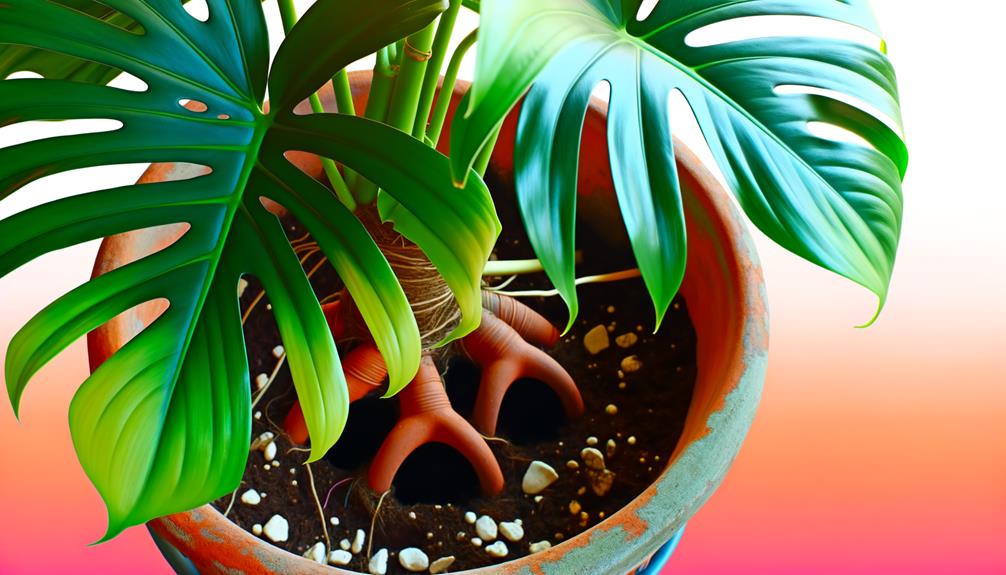
Ensuring the finest soil and drainage for your Monstera is vital, as it directly impacts the plant’s ability to absorb nutrients and avoid root diseases. Select a well-aerated, loose soil mix that includes components like peat moss, perlite, and pine bark.
This combination promotes ideal root health by providing necessary aeration and moisture retention. Good drainage is essential; using a pot with drainage holes prevents waterlogging, which can lead to root rot.
Here’s a helpful summary:
| Component | Function |
|---|---|
| Peat Moss | Retains moisture |
| Perlite | Enhances aeration |
| Pine Bark | Improves drainage |
| Drainage Holes | Prevents waterlogging |
| Soil Mix | Provides balanced nutrients |
Watering Needs
When evaluating the watering requirements of your Monstera, it’s essential to maintain ideal moisture levels to promote healthy growth. Evidence suggests that overwatering can lead to root rot, a common issue in root-bound plants.
To minimize this risk, use a moisture meter to guarantee the soil stays consistently damp but not waterlogged.
Optimal Moisture Levels
Maintaining ideal moisture levels for Monstera plants involves understanding their preference for consistently moist but not waterlogged soil. This can be gauged by monitoring the top inch of soil for dryness before watering. This method guarantees the soil retains sufficient moisture without causing root rot.
A moisture meter can be an invaluable tool in achieving this balance, offering accurate readings. Additionally, incorporating well-draining soil mixes, such as those containing perlite or orchid bark, enhances moisture control.
Regularly checking soil moisture levels, especially during seasonal changes, helps maintain optimal hydration. Consistency is key; sudden fluctuations can stress the plant. By understanding these nuances, you guarantee your Monstera thrives with healthy root systems and robust foliage.
Overwatering Risks
Overwatering Monstera plants can lead to severe root rot, compromising the plant’s ability to absorb nutrients and ultimately threatening its survival. Root rot, caused by pathogens like Pythium and Phytophthora, thrives in waterlogged soil conditions. When roots remain submerged, oxygen levels diminish, promoting anaerobic bacterial growth.
You’ll notice yellowing leaves, wilting, and a foul odor from the soil. To mitigate these risks, ensure proper drainage by using a well-aerated, chunky potting mix and a pot with drainage holes. Water only when the top inch of soil feels dry. Employ a moisture gauge for accuracy.
Light Requirements
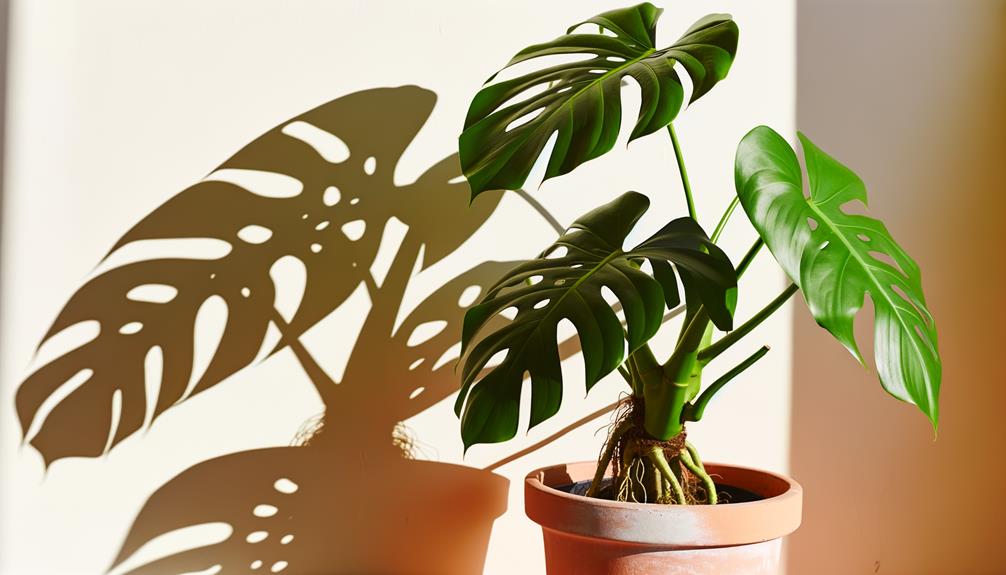
Ensuring ideal growth for Monstera plants hinges on providing them with bright, indirect light to mimic their natural tropical habitat. You should aim for light levels between 10,000 and 20,000 lux, simulating the dappled sunlight they receive under forest canopies.
Direct sunlight can cause photodamage, leading to leaf burn and chlorosis. Conversely, inadequate light reduces photosynthetic efficiency, stunting growth and causing etiolation. Utilize a light meter to quantify illuminance, ensuring consistent exposure.
Positioning your Monstera near an east or south-facing window with sheer curtains can optimize light conditions. Reflective surfaces and artificial grow lights with a color temperature of 5000-6500K can also supplement natural light, promoting robust foliage and overall health.
Common Mistakes
While providing ideal light is essential, several common mistakes can hinder the health and growth of Monstera plants. Overwatering is a frequent issue; it can lead to root rot, evidenced by yellowing leaves and a foul smell.
Another mistake is using the wrong soil type; Monstera thrive in well-draining soil with organic matter. Neglecting to repot can cause the plant to become root-bound, stunting its growth. Finally, improper fertilization can either burn the roots or cause nutrient deficiencies.
| Mistake | Consequence | Indicator |
|---|---|---|
| Overwatering | Root rot | Yellow leaves, foul smell |
| Wrong soil type | Poor growth | Compacted soil |
| Not repotting | Stunted growth | Roots circling the pot |
| Improper fertilization | Nutrient issues | Burned or yellow leaves |
Seasonal Care Tips
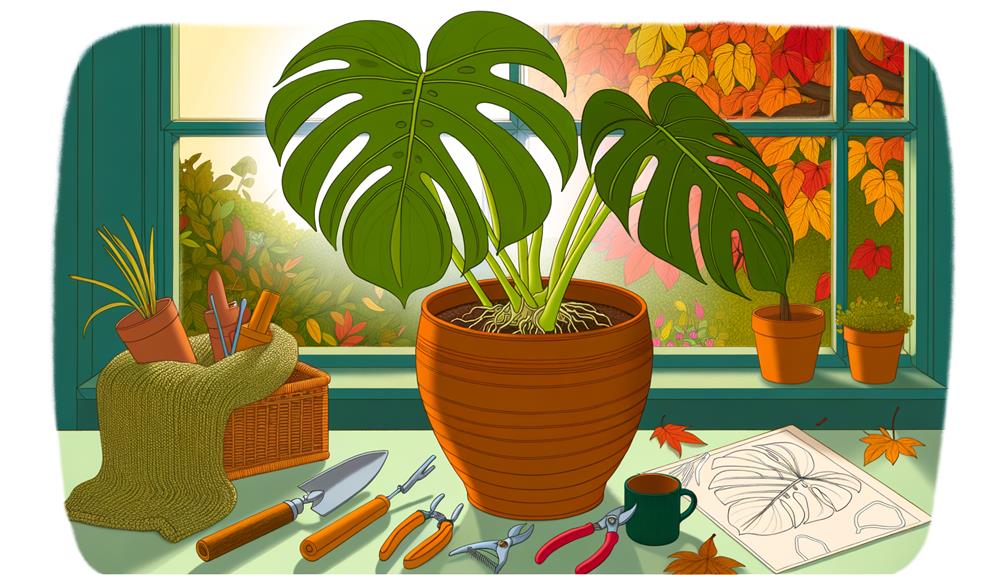
To keep your Monstera plant thriving year-round, it’s vital to adapt your care routine to the changing seasons.
During spring and summer, increase watering frequency and make sure the soil remains consistently moist but not waterlogged. This period is important for vegetative growth, so incorporate a balanced, water-soluble fertilizer bi-monthly.
In fall and winter, reduce watering to prevent root rot, as the plant’s metabolic rate decreases. Monitor humidity levels closely, aiming for 60-70%, especially in winter when indoor air tends to dry out. Utilize a hygrometer for accuracy.
Rotate the plant for even light distribution and clean leaves to maximize photosynthesis. Adjusting your care routine seasonally guarantees your Monstera remains healthy and vigorous throughout the year.
Long-Term Maintenance
Maintaining your Monstera’s health over the long term involves regular pruning, repotting, and monitoring for pests to guarantee sustained growth and importance.
Pruning encourages new growth and maintains the plant’s structural integrity. Remove yellowing leaves and any leggy growth to optimize light penetration and airflow.
Repot your Monstera biennially to prevent it from becoming root bound, which can inhibit nutrient uptake and stunt growth. Use a well-draining potting mix rich in organic matter to promote root health.
Vigilantly monitor for pests like spider mites and scale insects; early detection and treatment with insecticidal soap or neem oil are essential.
Adhering to these practices ensures your Monstera remains robust and continues to thrive.
Conclusion
Think of your Monstera like an athlete in peak condition. Just as athletes need room to stretch and grow their muscles, your Monstera needs space for its roots to expand.
Root-bound conditions can stifle your plant’s performance, leading to stunted growth and yellowing leaves. Repotting provides the necessary ‘training ground’ for your Monstera to flourish.
Data shows that repotted Monsteras can grow up to 30% larger, ensuring a lush, vibrant addition to your indoor garden.



